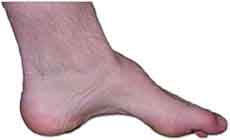

Charcot–Marie–Tooth disease CMT), known also as Morbus Charcot-Marie-Tooth, Charcot-Marie-Tooth neuropathy, hereditary motor and sensory neuropathy (HMSN), hereditary sensorimotor neuropathy (HSMN), or peroneal muscular atrophy, is an inherited disorder of nerves (neuropathy) that takes different forms. It is characterized by loss of muscle tissue and touch sensation, predominantly in the feet and legs but also in the hands and arms in the advanced stages of disease. Presently incurable, this disease is one of the most common inherited neurological disorders, with 36 in 100,000 affected.
Charcot–Marie–Tooth disease is caused by mutations that cause defects in neuronal proteins. Nerve signals are conducted by an axon with a myelin sheath wrapped around it. Most mutations in CMT affect the myelin sheath. Some affect the axon.
The most common cause of CMT (70-80% of the cases) is the duplication of a large region in chromosome 17p12 that includes the gene PMP22. Some mutations affect the gene MFN2, which codes for a mitochondrial protein. Cells contain separate sets of genes in their nucleus and in their mitochondria. In nerve cells, the mitochondria travel down the long axons. In some forms of CMT, mutated MFN2 causes the mitochondria to form large clusters, or clots, which are unable to travel down the axon towards the synapses. This prevents the synapses from functioning.
CMT is divided into the primary demyelinating neuropathies (CMT1, CMT3, and CMT4) and the primary axonal neuropathies (CMT2), with frequent overlap. Another cell involved in CMT is the Schwann cell, which creates the myelin sheath, by wrapping its plasma membrane around the axon in a structure that is sometimes compared to a swiss roll.
Neurons, Schwann cells, and fibroblasts work together to create a working nerve. Schwann cells and neurons exchange molecular signals that regulate survival and differentiation. These signals are disrupted in CMT.
Demyelinating Schwann cells causes abnormal axon structure and function. They may cause axon degeneration. Or they may simply cause axons to malfunction.
The myelin sheath allows nerve cells to conduct signals faster. When the myelin sheath is damaged, nerve signals are slower, and this can be measured by a common neurological test, electromyography.
When the axon is damaged, on the other hand, this results in a reduced compound muscle action potential (CMAP).
Symptoms
Symptoms usually begin in late childhood or early adulthood. Some people don't experience symptoms until the early thirties. Usually, the initial symptom is foot drop early in the course of the disease. This can also cause claw toe, where the toes are always curled. Wasting of muscle tissue of the lower parts of the legs may give rise to "stork leg" or "inverted bottle" appearance. Weakness in the hands and forearms occurs in many people later in life as the disease progresses.
Symptoms and progression of the disease can vary. Breathing can be affected in some; so can hearing, vision, and the neck and shoulder muscles. Scoliosis is common. Hip sockets can be malformed. Gastrointestinal problems can be part of CMT, as can chewing, swallowing, and speaking (as vocal cords atrophy). A tremor can develop as muscles waste. Pregnancy has been known to exacerbate CMT, as well as extreme emotional stress.
Diagnosis
CMT can be diagnosed through symptoms, through measurement of the speed of nerve impulses (electromyography), through biopsy of the nerve, and through DNA testing. DNA testing can give a definitive diagnosis, but not all the genetic markers for CMT are known. CMT is first noticed when someone develops lower leg weakness and foot deformities such as foot drop, hammertoes and high arches. But signs alone do not lead to diagnosis. Patients must be referred to a neurologist.
To see signs of muscle weakness the neurologist will ask patients to walk on their heels or to move part of their leg against an opposing force. In order to identify sensory loss the neurologist will test for deep tendon reflexes, such as the knee jerk, which are reduced or absent in CMT. The doctor will also ask about family history because CMT is hereditary. The lack of family history does not rule out CMT, but it will allow the doctor to rule out other causes of neuropathy such as diabetes or exposure to certain chemicals or drugs.
In 2010, CMT was one of the first diseases where the genetic cause of a particular patient's disease was precisely determined by sequencing the whole genome of an affected individual. Two mutations were identified in a gene, SH3TC2, known to cause CMT. Researchers then compared the affected patient's genome to the genomes of the patient's mother, father, and seven siblings with and without the disease.
The mother and father each had one normal and one mutant copy of this gene, and had mild or no symptoms. The offspring that inherited two mutant genes presented fully with the disease. Sequencing the initial patient's whole genome cost $50,000, but researchers estimated that it would soon cost $5,000 and become common.
Charcot-Marie-Tooth Disease Wikipedia